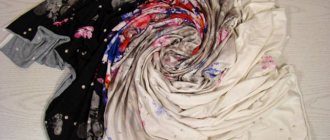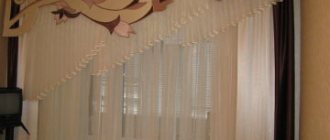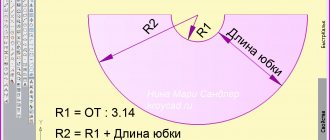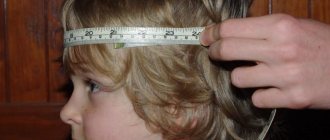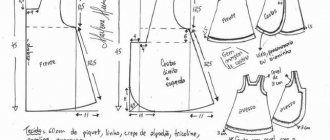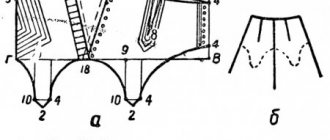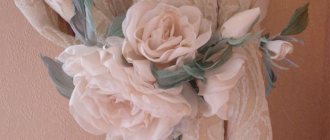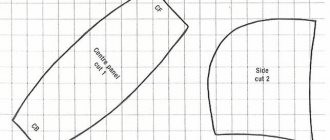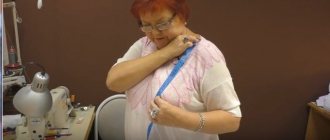Designing and sewing curtains with your own hands is an exciting activity that allows you to save money and show your imagination, and get incomparable pleasure from the creative process.
The original decoration of the window with curtains with a lambrequin gives the entire room sophistication and shows the sense of style of its owner.
If it is not too difficult to sew ordinary straight curtains of the classic version, then it is not so easy to make a more complex design, cutting a lambrequin, without having experience in cutting various products. However, having studied some techniques and understood the principle of constructing patterns using ready-made examples, you can learn how to independently cut lambrequin curtains of any complexity.
Curtains with swags: photos and types of products
Swag is an element of a lambrequin. It consists of several components - two shoulders and depth. A “shoulder” is placed along the cornice, and the depth is equal to the distance by which it is planned to lower the fabric down. Modern masters distinguish several types of swags, namely:
- symmetrical;
- with a vertical shoulder;
- asymmetrical;
- mechanical;
- with sagging.
Ordinary symmetrical curtains with swags can be easily made yourself. You don't even need a pattern for this.
Materials and tools
To make curtains with your own hands, you need to prepare materials and tools. The choice of the main canvas will depend on the purpose and type of interior. For the kitchen you need to select fireproof fabrics that do not absorb odors from dust and moisture. Polyester, linen and cotton fabrics are suitable for this. For other rooms the choice is unlimited. Experts recommend first selecting inexpensive fabrics to learn how to sew curtains, and then moving on to more complex designs and expensive fabrics.
Cotton for the kitchen
After selecting the desired fabric, you need to put in front of you threads with a needle, sewing machine, ruler, chalk, awl, scissors and a cornice with fastening.
List of required materials
DIY lambrequin: photo and sequence of actions
Sewing curtains with swags consists of several key stages. Let's look at them in more detail.
- First of all, you need to choose a suitable product model and draw up a sewing pattern.
- Using the dimensions of the swag, determine the required amount of material;
- Then we scale the finished curtain template and turn it into a pattern. All parts are placed diagonally on the fabric and cutting is performed.
- We proceed directly to sewing - we make folds, process the edges, sew seams, hem curtain tape or Velcro to securely fasten the product to the cornice.
Before you start sewing curtains with your own hands, be sure to measure all the necessary parameters of the future product. To do this you will need the following data:
- cornice length;
- half the length of the lower sag;
- depth.
The easiest way is to take accurate measurements of the window and go from there. If you plan to make a neat, symmetrical piece, place the pattern on fabric that has been previously folded in half.
Types of lambrequins
Lambrequin is a horizontally stretched strip of fabric attached to the top of the curtain on the cornice. Known since the 15th century and popular today in baroque and classic style interiors. It is combined in a modern variation with interiors in high-tech, country and modern styles. Made from silk, organza, chiffon, linen, voile and satin. There are different types. Differs in color, shape and size.
Lambrequin in the home interior
The classic version is the most common type of lambrequins. It differs from others by the presence of swags, ties and frills as decorative elements. It has a wavy, straight and arched shape. Covers an unsightly cornice or window top.
Classic model
The soft lambrequin comes with swag, semi-swag, frill, mold and puffs. It enjoys its popularity due to the fact that it creates a feeling of lightness in the interior.
Soft model
Bando is a decorative variety formed from rigid non-woven material. Serves as a good curtain addition if it matches it in design and color. Attached to the window using Velcro or glue. Gives the room a romantic feel. Can visually increase the space of a room.
Bando
The openwork version is a rigid non-woven decoration that does not have a continuous surface, but is presented in the form of lace with an ornament.
Note! It is not placed in the kitchen or bathhouse because it does not tolerate high humidity. Excess moisture causes it to deform and lose its aesthetic appearance.
Openwork lambrequin
A modular lambrequin is a complex structure that consists of elements of different sizes. It differs in width and massiveness. Consists of complex patterns and ornaments. Most often used in living rooms, dining rooms or libraries, made in a classic style.
Modular lambrequin
The plank option is an original strip decor that is suitable for a child’s room or bedroom in a modern style. Produced and marketed in rolls.
Plank model
An asymmetrical lambrequin is a decorative fabric element located unevenly and asymmetrically on window or door openings. Suitable as a decoration for cabinet furniture that blocks large windows, or a long classic cornice in large rooms. Looks good in interiors with a classic style.
Asymmetrical model
DIY lambrequin: lambrequin patterns
If you are not confident in your own abilities, use ready-made lambrequin patterns, which are presented below. But do not forget that you need to transfer them to the fabric taking into account your swag size.
To show your imagination and creativity, develop a sketch of a lambrequin yourself and then bring it to life. The diagram must be extremely accurate, it is advisable to use a scale of 1:10. For example, a five-meter lambrequin on paper will be equal to 50 cm. This will greatly facilitate the process of taking measurements. If you are fluent in a graphic editor, create a pattern directly on your computer.
Sewing a rigid lambrequin
A rigid lambrequin is a bondo or decorative curtain element created on a dense non-woven material. It is called bondo because it is created using the material of the same name, which is glued to the main fabric. This ensures the required shape. In addition to aesthetics, it serves the function of removing the cornice and placing curtains. Also used to visually increase the height of ceilings.
To create a rigid lambrequin, you need to take the main fabric, bondo, decorative fittings, threads, pins, paper, Velcro, scissors, iron and sewing machine. To form a more voluminous rigid cut material, you can use a polylon layer.
Bondo as the main material for sewing rigid lambrequin
To shape the product, you need to make a life-size pattern on paper, starting from the dimensions of the length of the cornice. To do this, you can study the material, how patterns of lambrequins with life-size dimensions are made.
Next, transfer the pattern to the adhesive material. Cut the product without allowances. Then secure the resulting workpiece with pins and iron it until the adhesive fabric is completely attached to the curtain. Afterwards make a lining layer. To do this, place the blanks on a piece of fabric, trace and cut out the patterns. Attach the lining to the main piece with pins so that the right sides match and the adhesive fabric is at the top. Sew all sides except the top end. Turn the lambrequin right side out and iron it again. Sew or glue velcro along the top where the cornice will go.
If the product has rounded or sharp bends, before turning it inside out, it is necessary to make notches along all edges. This will remove any tension in the fabric and ensure that the fabric lays beautifully and retains its shape.
You can decorate the created lambrequin with tassels, threads, beads, and beaded ropes hanging beautifully from the bottom. This will revive any lambrequin model and make the interior original, regardless of the color scheme of the room or its style.
You might be interested in: Patterns and sewing of blouses, tops and dresses with peplum
Note! Before sewing, it is necessary to take into account the shrinkage of the fabric and study how to make a lambrequin pattern correctly. With high humidity, the product will lose its shape, warp or be deformed in other ways. To avoid this situation, it is necessary to wash, dry and iron the lining or base layer before sewing.
Hard lambrequin
What is a mold: pattern and photo
The vertical part of most lambrequins with vertical folds converging in the central part is called a mold. The pattern of a classic product in a straight line looks like this:
You only need 3 measurements:
- height of the middle part of the mold;
- side height;
- width along the eaves.
The standard product consists of 10 folds. In this case, the distance between them should be no more than 5 cm. The width allowance is 20-22 cm.
To calculate the distance between pleats, use the following formula:
(Product width – 20 cm): 8 = X, where X is the required number
When cutting, do not forget to create small notches that will allow you to correctly assemble the mold.
Beautiful, elegant and timeless curtains with your own hands are easy. The main thing is to be patient and not give up if things don’t work out. Over time, such crafting can turn into a favorite activity, bringing good income and pleasure.
Variety selection
Before you sew a lambrequin, you need to decide on the variety and look at the lambrequin patterns with your own hands. It should be selected based on the specifics of the room and the stylistic direction of the room. In this regard, it is worth considering some tips:
- When guests visit the room, there is no need to hang thin and light canvases so as not to damage them;
Hanging thick fabrics to prevent them from quickly deteriorating
- It is better to hang fabric curtains in the kitchen that can be easily cleaned when dirty;
- On small windows, there is no need to hang long ones with heavy canvases;
- Observe the color scheme and general style when choosing curtains.
You might be interested in: The reasons for missing stitches when sewing with a sewing machine and how to repair them
Installation of partiers in accordance with the color scheme of the room
As for the last point, you can select lambrequins based on the general style of the room. Expensive canvases with a variety of European decorations fit into Baroque style rooms.
Baroque style model
Lush, asymmetrical and semi-swagger models, complemented by gilding, fit into a room with a Rococo stylistic orientation.
Rococo style curtains
Note! In retro and shabby chic interiors, you should choose not overly refined and artificially aged lambrequins with ribbon embroidery or rustic ornaments.
For a room in a modern or high-tech style, you should choose openwork options in combination with Roman blinds. Give preference to the minimalist option.
High-tech style curtains
Lambrequin for a children's room
To sew a simple classic children's lambrequin, you need to familiarize yourself with the material, how to cut out lambrequins yourself, step-by-step instructions. Next, calculate the length and width of the product. Next, using ready-made cutting samples, make fabric blanks and process the side sections. To do this, fold the side edges, iron and stitch. For a neater appearance, fold the edges twice.
After processing the side cuts, you need to make the bottom and design a pocket for the cornice according to a step-by-step master class. To do this, fold the top edge and attach it to the bottom. Iron and stitch. Next, evaluate the work by trying on the finished curtain to the window or doorway. If you find excess threads, remove them using fire. This is the main condition for creating a beautiful product.
Option with a pocket for a curtain rod
You can decorate the curtain with satin, sateen and other braid, emphasizing the edges of the curtain or the borders of several fabric varieties. You can also complement it with large flowers: a floral pattern made of soft fabrics in bright colors can make a girl’s room elegant and original. For boys, you can decorate the product by drawing your favorite cartoon characters on canvas using special fabric paints.
Decoration of a children's lambrequin model
Fastening
The lambrequin is attached to cornices, window and door openings in different ways. There are fastenings with loops and ties. These are fasteners presented in the form of satin, satin bows, silk ribbons, rope cords or cotton laces.
Tie fastening
There is a lambrequin fastening to the eyelets. These are metal or plastic rings, available in different colors and sizes. Consists of a block and a leg. Art Nouveau, shabby shake and even vintage interiors are aesthetically complemented.
Eyelet fastening
Note! There is also a tape mount. This is a decorative fitting that allows you to attach curtains to cornices and openings using glue and Velcro. The most common model on all types of lambrequins.
In general, a lambrequin is a decorative transverse fabric strip that can be used to decorate window and door openings. They are able to give the room the effect of luxury and wealth. This design can not only make the room beautiful, but also emphasize its style, becoming a highlight. Lambrequin can be classic, soft, openwork, modular, plank and asymmetrical. Also available in bondo form. Can be decorated with a swag, half-swag, perekid, jabot, tie and puff. Easy to sew using the classic pattern and detailed instructions. Attaches with loops, ties, eyelets and Velcro strips.
What is a lambrequin
Lambrequin is a horizontal piece of fabric covering the top of the window. The main curtains and/or tulle are hung behind the decorative element. In width, this final detail of the window design most often occupies the entire cornice, and in height it is no more than 1/6 of the length of the curtains. Such products can be soft draperies or rigid frames covered with material.
Similar decorations are used to decorate doorways and interior arches. The manufacturing technology of the structure remains the same, only its function changes.
Design ideas for interiors
The decor of the curtains is selected depending on the room in which the windows are decorated.
Kitchen
Short, straight, rustic-style curtain models are suitable for kitchens. The fabric on the windows should be practical: not absorb odors, not collect dust and wash well.
Living room
Window design in the living room depends on the size of the room. The small hall will be visually enlarged by openwork bandeaus.
In large rooms, lush draperies and richly decorated massive decorative elements of curtains are appropriate.
The color of the lambrequin should be darker than the walls and curtains.
Bedroom
Combination models made of gangs with soft swags and light lambrequins made of translucent fabric with a minimum of decorations add coziness and light to the bedroom.
Children's
Lambrequins with large applications in the form of clouds, animals, and fairy-tale characters are suitable for children. Children's slips are suitable as an example for drawings.

